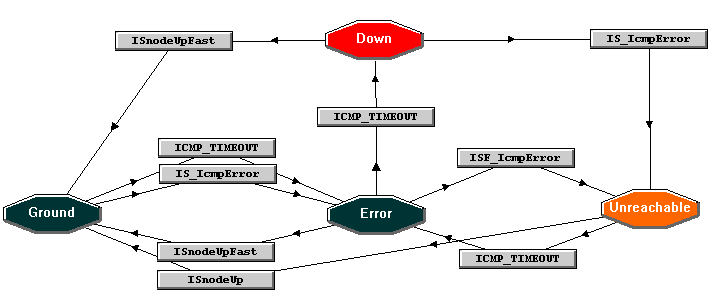Designing and Managing Behavior Models
-
Using Other Data Sources - NerveCenter's Built-In Triggers - An Example Using Built-In Triggers -
NerveCenter's Built-In Triggers
Another NerveCenter
An Example Using Built-In Triggers
This section looks at how some of the built-in triggers are used in one of NerveCenter's predefined alarms: IcmpStatus. The behavior model of which this alarm is a part repeatedly pings a node to determine its status.
To make the ICMP status behavior model functional, you must turn on the polls IS_IcmpPoll and IS_IcmpFastPoll and the alarm IcmpStatus.
IcmpStatus Alarm

We won't look at every transition in this alarm, but let's look at the alarm's basic design.
While the alarm is in the Ground state, NerveCenter is looking for a:
- An error response
(Not an nl-ping-response nor a port unreachable -- both indicate that the node is up)
- No response
(ICMP timeout indicated by the built-in trigger ICMP_TIMEOUT)
If NerveCenter receives an error response or a timeout, the alarm transitions to the Error state.
From the Error state, several things can happen:
- If the node responds to a ping (in which case, either the ISnodeUp or ISnodeUpFast trigger will be fired by a poll), the alarm transitions back to Ground.
- If the alarm receives another error response, it transitions to the Unreachable state. When the alarm transitions to this state, it puts the node being monitored in a suppressed state.
- If the alarm receives another ICMP_TIMEOUT trigger, it transitions to the Down state. On this transition, the alarm puts the node in a suppressed state and sends a message about the problem to a network management platform.
This is only a cursory look at the IcmpStatus alarm, but it should give you an idea of how alarms can make use of NerveCenter's built-in triggers.